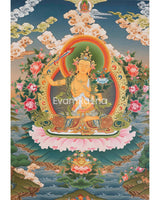
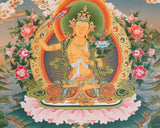
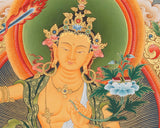
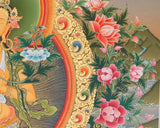

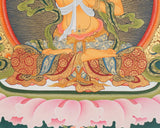

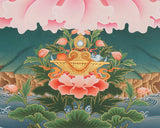
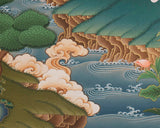
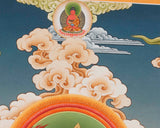
Boddhisattva Manjushri Prints | Vajrayana Buddhism

100% AUTHENTIC

FREE SHIPPING
Boddhisattva Manjushri Prints
Introduction To The Thangka Print :
The multi-colored rays emanating from his golden skin signify the many ways by which he leads people to wisdom. The sword in his right hand represents the knowledge that cuts through ignorance in the minds of unenlightened beings. The sutra he carries in his left hand represents the primary means by which wisdom takes root in beings, which is the beginning of their journey towards omniscience. The flowers around him indicate that just as the flower is not tainted by the mud from which it emerged, he too is unstained by the faults he once carried in his mind as an ordinary being. He is also often depicted in a triad with Avalokiteshvara and Vajrapani known as Rigsum Gonpo, symbolizing the qualities necessary for enlightenment – compassion, wisdom and power.
According to one tradition, he attained perfect enlightenment a long time back. The Buddhists believe that he is the sole deity of wisdom who blesses the devotees to sharpen their memory and intellect. As a result, a devotee can penetrate the vast and profound meanings of the Buddha's teachings. Without the blessings of Mañjushri, nobody can develop the realization of emptiness.
How does Thangka benefit us?
It goes without saying that every detail of a painting has a symbolic meaning. Regardless of your religious affiliation, a thangka can help you on your path to enlightenment, whether you practice Buddhism or have other religious convictions. Thangkas are paintings that depict deities with various iconographic elements and symbolism that encourage meditation on the teachings of the god they depict. Any thangka is intended to aid in the removal of the film of ignorance, which is a significant barrier to the road to enlightenment. The Thangka is revered as a holy item. They promote positivity, spread Buddhism's teachings, bring about peace, harmony, and oneness, and dispel any negative energy that may be there.




















